Menus
- How good is the new naked bike?
- Switching to sport driving mode does not help
- 4.8 liters per 100 kilometers
- The emphasis is clearly on comfort
- Front feels suspiciously light
- Traction control allows wheelies
- MOTORCYCLE conclusion
- The competition
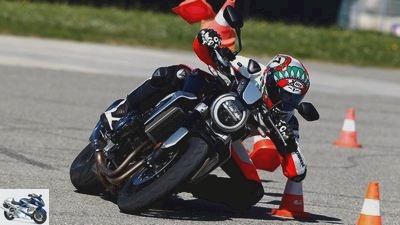
factstudio.de
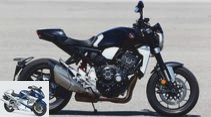
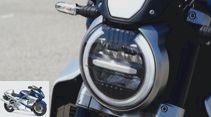
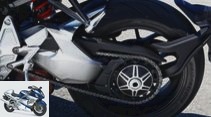
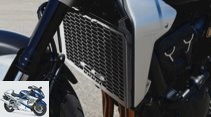
15th photos
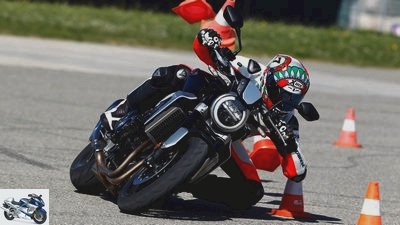
factstudio.de
1/15
Honda CB 1000 R + in the top test.
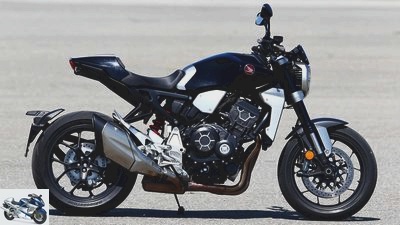
factstudio.de
2/15
The design line of the new CB 1000 R is called “Neo Sport Cafe”. Nothing is said about the appearance of the motorcycle, but the CB shows what could be meant by the term.
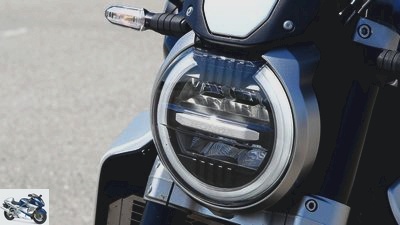
factstudio.de
3/15
The lighting technology deserves the term “Neo”. A classic round headlight housing is combined with LED lights.
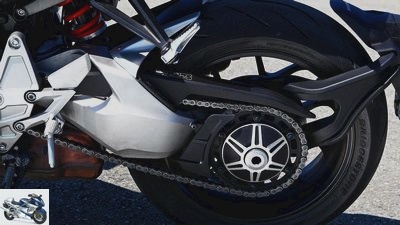
factstudio.de
4/15
Like its predecessor, the new CB 1000 R also has a single-sided swing arm. The license plate holder screwed to it is new.
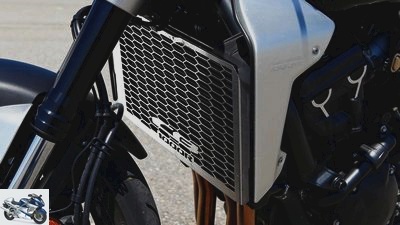
factstudio.de
5/15
Like the Quickshifter, this radiator cover is part of the accessory package that turns the CB 1000 R into a CB 1000 R +.
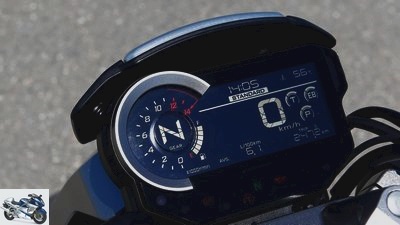
factstudio.de
6/15
The rev counter is almost impossible to read in shady passages. The rest of the information is easier to see.
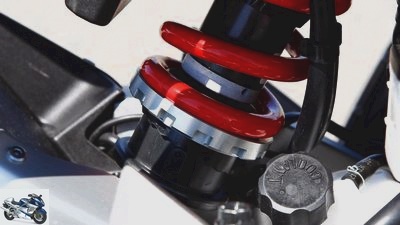
factstudio.de
7/15
The spring strut is adjustable in preload and rebound. Theoretically. In practice, however, the rebound stage should always remain closed.
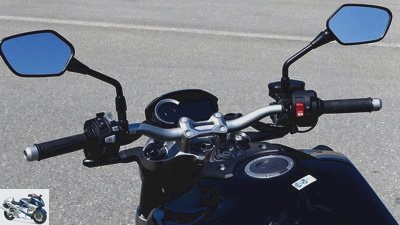
factstudio.de
8/15
The handlebars made of tapered aluminum tube are comfortable to hold, and there is limited consideration in the mirrors.
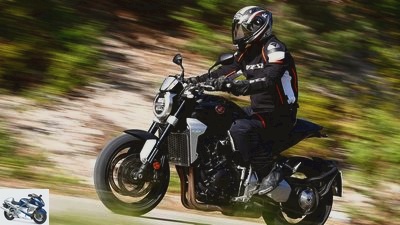
factstudio.de
9/15
This color variant of the CB 1000 R plays with the contrast of black and brushed aluminum surfaces.

factstudio.de
10/15
Well done: The exhaust system is a model of the art of welding and pipe bending – regardless of whether it is done by humans or robots. Covers keep the heat away from the crew’s boots.
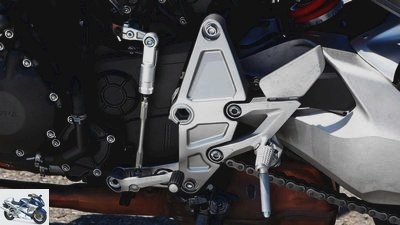
factstudio.de
11/15
Smooth quickshifter: The gearshift assistant deserves a plus, not for existence, but because it works well. At low load and speed, however, it is better to shift with the clutch.
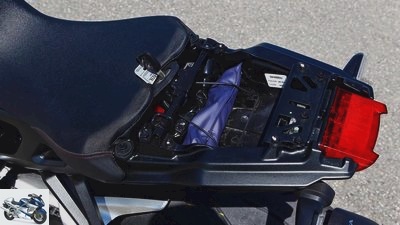
factstudio.de
12/15
Little space: Not only is the design of the rear minimalistic, but also the storage space that remains under the pillion seat. It’s getting claustrophobic for a big wallet.
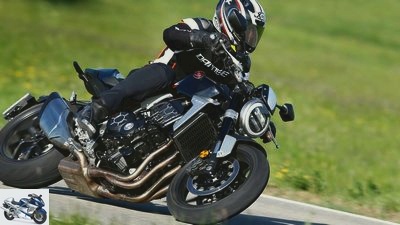
factstudio.de
13/15
The very good standard tires – Bridgestone S 21 M – invites you to take fast turns.
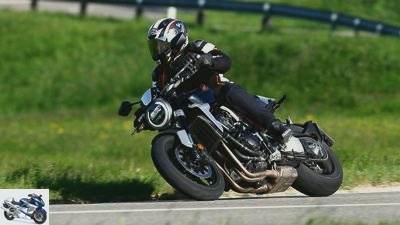
factstudio.de
14/15
For the Honda in the test equipment, 14,485 euros have to be put on the counter.
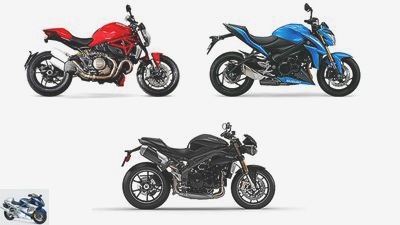
r-photography.info, Suzuki, Triumph
15/15
The competition arises from the Ducati Monster 1200 (l.o.), the Suzuki GSX-S 1000 (r.o.) and the Triumph Speed Triple S (below).
Honda CB 1000 R + (2018) in the top test
How good is the new naked bike?
Is the Honda CB 1000 R + such a cornering sweeper that the hats fly when you turn boldly? Obviously, she supports spectacularly super-sporty feats like in the lead photo. But in the course of the top test completely different character traits came to light.
Black and evil, silver or red and a little less evil – the Honda comes in these three variants C.B 1000 R available. And as this description suggests – no matter which paint finish you choose, its exterior always signals a well-measured degree of machismo and rough charm. The towering front looks beefy, the short rear makes a streetfighter, painted surfaces in muted colors contrast sharply with milled, brushed or natural-colored anodized aluminum surfaces. Pressing the starter button unleashes a pithy, dark exhaust sound, and when the driver touches the clutch lever for the first time, he expects a strong handshake in the form of firm restoring forces.
Buy complete article

Honda CB 1000 R + (2018) in the top test
How good is the new naked bike?
2004 Fireblade engine
Not even close. The lever can be pulled towards the handlebars with ease, the four-cylinder, which is based on the engine of the Fireblade type SC 57 from 2004, runs almost vibration-free in the lower and middle speed range and when rolling the Honda feels like the two-wheeled counterpart Luxury sedan. The transmission only occasionally lets out a slight bang when engaging first gear; Most of the gear changes are as if you were dabbing the lever with a cotton ball and as if this impulse was already sufficient to engage the next gear. No matter whether you switch with the clutch insert or use the quickshifter. Admittedly, this last comparison is a little exaggerated, but if you want to work out the true character of the Honda CB 1000 R, you need the more pointed formulation. To get to the point: Under the tricky macho outfit is a highly cultivated and civilized motorcycle.
factstudio.de
The engine of the new CB 1000 R comes from the 2004 Honda Fireblade.
This main feature of the CB character does not only have advantages. In an effort to make the Honda CB 1000 R as safe and suitable for everyday use as possible, the engine developers have overshot the target and have given the four-cylinder engine a remarkable performance. To put it succinctly: it starts out weakly and then slackens off strongly. Even at 3,000 rpm, the torque is a good 15 Nm below that of the previous model (type code SC 60) and between 4,500 and 8,000 rpm, the power and torque curve form a pronounced dent, which in some areas is up to ten hp and 20 Nm below the values of a 2016 model. During the presentation at the Eicma in Milan and the driving presentation, the Honda representatives dealt aggressively with this characteristic by arguing with the safety gain that it brings with it. You just shouldn’t put too much tension on the rear tire when accelerating in an inclined position. It is even plausible that there is actually intention and not inability behind this vote. However, the argument doesn’t work; while driving, it quickly reveals itself to be the brainchild of unrealistic concerns.
Switching to sport driving mode does not help
Because instead of providing a full, evenly build-up of torque that promotes a round, relaxed driving style, the engine lets you hang in the torque hole after every slightly tighter curve. At the beginning, the testers thought that a very defensive set-up of traction control was responsible for this, especially since when accelerating out of corners it feels as if a lean angle sensor would only release the full torque when the Honda CB 1000 R is almost straight again. Upon closer observation, it turned out that it is no longer released even if the motorcycle is upright. Not even when the traction control is at its sharpest.
factstudio.de
The quickshifter of the CB 1000 R works well.
Only beyond the 8,000 mark does the revised engine of the Honda CB 1000 R outperform its predecessor and pull the driver’s arms out when accelerating. But if you turn it off on the country road into these areas, you are anything but safe on the road. Switching to the Sport driving mode does not help either. The power delivery remains the same, only the throttle response gets harder, and that doesn’t fit together anymore. Harsh load changes and little behind – thank you, no need. And for all those who want to criticize the testers of stokers and performance fetishism, it should be emphasized here once again: The full and evenly developing performance of a “only” 125 PS strong SC 60 would have been enough at most.
4.8 liters per 100 kilometers
The fact that the new Honda CB 1000 R goes from 60 to 140 km / h despite all this is two tiny tenths of a second faster than its predecessor in the last gear is due to the lower weight and the shorter secondary ratio. It must be added that part of the gain in traction is used to compensate for the somewhat larger rolling circumference of the current 190/55 compared to the earlier 180/55 rear tire. And at least the consumption measurement showed in which area the engine developers had worked successfully: 4.8 liters per 100 kilometers is very moderate for a 1000 in this performance class. Does this modesty in gasoline consumption represent the positive side of the restrained performance? Well, the Suzuki GSX-S 1000 swallows even less fuel, but delivers ample power and torque curves as well as higher peak values. Also in Euro4 homologation.
factstudio.de
The very good standard tires from Bridgestone invite you to take a quick cornering.
When comparing basic chassis data, there are only minor differences between the old and new Honda CB 1000 R. The new wheelbase is ten and the caster one millimeter longer than the predecessor, the steering head angle is the same. Ultimately, it is the already mentioned high front section and the seat that has been moved a little further back that create a completely different driving experience. The handlebars are three centimeters higher than on the SC 60, and the driver sits relatively upright and very comfortably behind them while he controls his motorcycle with a good overview of the game.
The emphasis is clearly on comfort
With a decidedly sporty driving style on the Honda CB 1000 R, however, the driver can watch himself trying to bring more and more weight forward in an attempt to get more precise front wheel control and better feedback. This is only possible to a certain extent; unless you wanted to maintain a driving style in public transport like top tester Karsten Schwers in the photo on the left. And he only drove particularly sharply in a small segment of the circular path for the photo. After the photo area, he had to straighten the machine again and use another arch. He drove the speed and lap time in the circular path in a normal sitting position, steady pace and without bumping into the pylons.
Ultimately, this means that the relaxed seating position on the Honda and its slightly rear-heavy design impair the front wheel control from a certain area. This area is by no means only accessible on the racetrack or on the top test course, but also by ambitious drivers on winding country roads. This slight uncertainty has nothing to do with insufficient front tire grip. It’s more about how the chassis geometry, damping settings, weight distribution and ergonomics allow you to use the grip of the tire. And here the Honda CB 1000 R clearly emphasizes comfort, not sportiness.
Front feels suspiciously light
This explains their decent, but not exactly exhilarating performance in the slow slalom of the course with its tightly drawn arches. In fast slalom, where nimble changes in lean angle are crucial at high speeds, the soft tuning of the damping is noticeable in addition to the rear-heaviness. Even with a low preload, the rebound stage on the shock absorber must be completely closed – the mechanics from Honda Germany had already turned it off completely on the test machine. Nevertheless, the swing arm still wedges down sharply in the lean angle changes when passing through the zero position and lets the tail bounce. The front also feels suspiciously light. Because the Honda CB 1000 R likes to stand on the rear wheel when starting and accelerating after the reversal point, both wheels are rarely on the ground during the entire slalom run. A clear signal – more is not possible.
factstudio.de
The design line of the new CB 1000 R is called “Neo Sport Cafe”.
Up to this point, the Honda CB 1000 R willingly steers in and dives into deeper lean angles without tilting or appearing stubborn on the other hand. It’s almost playful and a lot of fun. Everyone who is interested in her should, however, please think carefully about what he expects from her. Friends of easy curve swing will get their money’s worth and enjoy high suspension comfort at the same time. The large unsprung masses of the single-sided swing arm can only be felt in hard bumps, and it reacts more slowly than the fork and the hindquarters rumble over bumps.
Traction control allows wheelies
Deliberately – according to the press release – the traction control of the Honda CB 1000 R wheelies allows. At this point, the developers don’t seem to have any security concerns. Once again, they were very careful when setting up the ABS. Despite the relatively long wheelbase and a lot of weight on the hindquarters, the ABS controls defensively; the average deceleration of 9.2 m / s² is at the level that Honda has not wanted to exceed for many years, so that no high stoppies or even rollover occur even on slopes. A sensor box, which records the position of the motorcycle in space, could allow greater delays and at the same time limit the lifting of the rear wheel. This effort was saved as well as a multicolored display instrument. At least most of the information is easy to read, but the tachometer is not. For 12,985 and 14,485 euros (model variant +) you can expect more.
factstudio.de
For the Honda in the test equipment, 14,485 euros have to be put on the counter.
As far as the classic processing virtues are concerned, however, the CB Honda 1000 R offers the usual high Honda standard. A beautiful surface finish, a carefully welded stainless steel exhaust system, discreetly laid cables and hoses, high-quality components and tires will delight even the most critical observer. The increased appreciation of classic shapes in recent years is accompanied by an awareness of what motorcycle designers call material authenticity. What looks like metal should also be metal, and the Honda is not naked in this regard. The lasered model names in the aluminum radiator trim look very elegant. The test machine with the + behind the model name offers various special equipment such as the Quickshifter, which enables up and down shifting without a clutch, as well as heated grips, a protective grille for the radiator and a fender made of aluminum sheet application for an extra charge of 1,500 euros. In the photos you can see the machine with the pillion seat cover, which is available in addition to the rear bench seat. The silver-colored middle part is also made of sheet aluminum.
MOTORCYCLE conclusion
How is it made up, the real character of the Honda CB 1000 R? Honda probably doesn’t know that for sure. After all, the top test revealed one thing: In the conflict between macho appearance and softie appearance, softie characteristics predominate – good drivability and smoothness, lots of comfort. What the strange performance characteristics are supposed to do remains incomprehensible.
The competition
Ducati Monster 1200
Two-cylinder V-engine, 147 hp, weight 219 kg, 0-100 km / h 3.4 seconds, Vmax 250 km / h, consumption 4.7 liters, 14,695 euros *
r-photography.info, Suzuki, Triumph
Ducati Monster 1200 (l.o.), Suzuki GSX-S 1000 (r.o.), Triumph Speed Triple S (below).
Suzuki GSX-S 1000
Four-cylinder in-line engine, 146 hp, weight 212 kg, 0–100 km / h 3.0 seconds, Vmax 240 km / h, consumption 4.7 liters, 11,724 euros * 1
Triumph Speed Triple S.
Three-cylinder in-line engine, 150 hp, weight 214 kg, 0-100 km / h 3.4 seconds, Vmax 250 km / h, consumption 4.5 liters, 14,200 euros *
*Incl. Additional costs, 1: promotional price
Related articles
-
Honda VTR 1000 test V-Lenz Spring is all about the new two-cylinder. In the spotlight: Honda’s VTR 1000 F. You didn’t like to read it, those responsible…
-
fact Concept comparison Honda CBR 1100 XX Kawasaki ZX-12 R Suzuki GSX-R 1000 Suzuki GSX 1400 Yamaha FZS 1000 Fazer Yamaha FJR 1300 Six bombs The six …
-
BMW F 800 GT, Kawasaki Z 1000 SX and Honda VFR 800 F in the test
fact 44 pictures fact 1/44 fact 2/44 fact 3/44 fact 4/44 fact 5/44 Praise to the diversity: The three test candidates all want the same thing, but are looking for it …
-
BMW F 800 GT against Honda CBF 1000 and Suzuki GSX 650 F
Bilski 18 pictures Bilski 1/18 The three all-rounders: Honda CBF 100 F, BMW F 800 GT and Suzuki GSX 650 F in a comparison test. Bilski 2/18 Sporty …
-
Endurance test Honda CBR 1000 RR Fireblade SC77
Jorg Kunstle. 19 pictures Andreas Bildl 1/19 The ignition lock of the Fireblade no longer wants to give up the key – a little oil helps. Volkmar Jacob 2/19 …
-
Driving report Honda CRF 1000 L Africa Twin (part 1)
Honda 13 photos ULA SERRA PRATS 1/13 Honda Africa Twin. 2/13 270 degree crank pin offset, long, continuous shaft with two balance weights in front of the…
-
Honda CBR 1000 F Type SC 21 Ride with the classic
12 pictures Stefan Wolf 1/12 The 1980s Honda CBR 1000 F is the ultimate yogurt cup. We took a trip with the classic. Stefan…
-
Honda Crossrunner and Suzuki V-Strom 1000 in comparison test
fact 30 pictures markus-jahn.com 1/30 Honda Crossrunner and Suzuki V-Strom 1000 in the comparison test. markus-jahn.com 2/30 Honda Crossrunner and Suzuki …
-
Driving report Honda VTR 1000 time shift Japan is eight hours ahead of Germany, Honda is four weeks behind Suzuki – at least when it comes to the first…
-
Honda CB 1100 R, Honda VF 1000 R in the test
Jahn 16 pictures Jahn 1/16 athletes in tails – the two long-distance racers from the Honda brand in comparison. Jahn 2/16 Very fine detail, from racing …